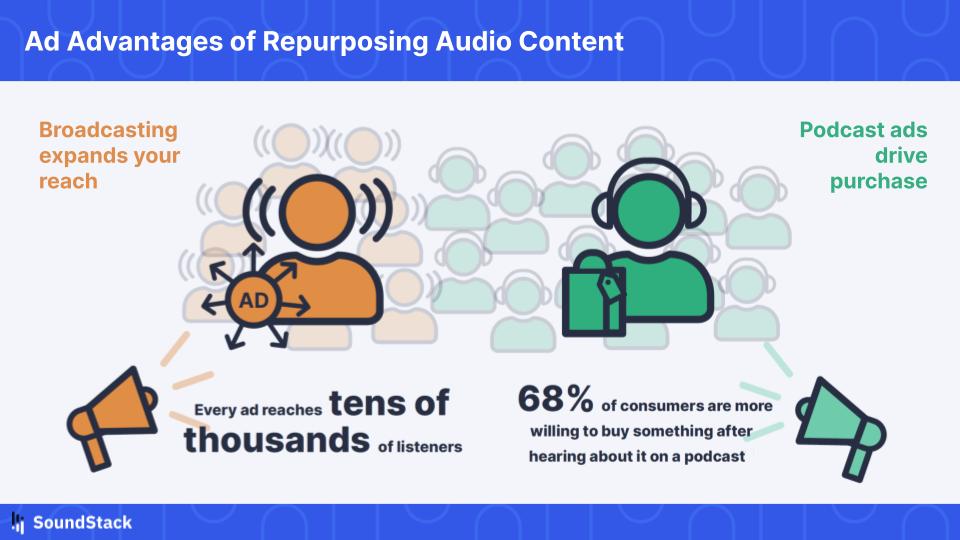Today in the Business of Podcasting
Dentsu Brings Keyword Buying to Connected TV to Improve Brand Safety and Targeting by Jack Neff
Using GumGum’s Verity platform and Iris.tv, Dentsu’s Contextual Intelligence for CTV (connected television) offers keyword targeting at the video level. While available in most text-based forms of advertising, the ability to target words inside video content opens up a variety of opportunities in both brand safety control and serving relevant advertising. Theoretically Dentsu’s new tool will allow advertisers to specifically avoid individual topics, such as extreme violence, instead of outright blocking ads before every R-rated movie. It’s worth noting keyword buying is already doable in podcasting, and both GumGum and Iris have been showing interest in the audio industry. [Source]
Amazon Music launches Podcast Previews in several global markets by Reem Makari
Podcast audiences using the Amazon Music app in the UK, Ireland, Australia, and New Zealand now have access to a new discoverability tool named Podcast Previews. Originally launched in November of last year in the US, Podcast Previews are clips hand-selected by podcasts from networks like Wondery and Sony Music Entertainment. Listeners visiting the Podcast Previews section of Amazon Music are then given clips based on contextual data like their subscriptions, podcast listening history, and previous engagement with Previews. [Source]
ACA study reveals the three factors driving the best returns in advertising
The Australian Council of Advertising has published new research on the effectiveness of advertising. The three biggest factors found involve platform, creativity, and spend. Attention decays at different rates on different platforms. Well-produced ad creatives won high-attention media platforms can increase effectiveness as high as 65%, but a good ad can’t overcome the limitations of low-attention platforms. As for spend, the adage “you have to spend money to make money” remains true. A campaign that pays attention to all three, running creative that fits each platform and spends enough to get said creative the attention it needs, has a higher likelihood to maximize return on investment. [Source]
YouTube and Podcasts by Adam Bowie
Bowie breaks down YouTube’s current place in the podcasting sphere, how it might have been accidentally overlooked, and unanswered questions that could evolve YouTube’s place in podcasting. The eternal question of “what is a podcast” complicates research into the top contenders, as studies like those from Podtrac don’t even mention YouTube due information being collected via RSS prefix. Meanwhile grey area productions, such as content exclusive to Spotify, Audible, and other platforms continue to be classified as ‘podcasts.’ There’s utility to YouTube, with the right investment. Bowie revisits research done by Ashley Carman into the under-performance of audio content ported to YouTube and finds that audio podcasts with static images or simple audiogram animations still underperform in comparison to full video productions presented as podcasts. [Source]
Why Spotify is Growing its Connected TV Ad Business by Parker Herren
Spotify has partnered with Roku in the first move to create the soon-to-be-formally-introduced Spotify CTV Partner Network. The network will both act as a hub to distribute video ads to CTV platforms and as a way to connect to services those advertisers can further retarget audiences. The initial launch of this comes with video ads on Spotify’s Roku channel. Given that audio-focused apps on connected TVs are usually background audio, Spotify encourages advertisers to tune creatives specifically for that environment. Something podcast ads are particularly good at doing. [Source]
…as for the rest of the news: Steve Pratt’s newsletter series interviewing Tom Webster focuses on defining your podcast’s audience, Hot Pod interviewed two people fluent in Spanish to review Spotify’s voice AI translations pilot program, and MarketingBrew looks at how to create an effective affiliate marketing campaign for this holiday season.
Data Snapshot

Source: Why broadcasters should also become podcasters, and vice versa, now.
What it Says: both broadcasting and podcasting have unique strengths as it relates to ads. For example, Radio’s one-to-many distribution ensures that every ad reaches massive numbers of listeners, and its linear format makes the inability to skip ads an added benefit. Podcast ads, from host-read to ‘produced,’ compel listeners to buy, to the tune of 20 percentage points higher than AM/FM radio.
What it Means: running your content in both formats yields a composite ad benefit for the audio publisher — more listeners and attention, higher propensity to purchase, and a lot more.
What Makes it Cool: it (and many other examples like it) cuts to the core of why taking a complementary approach to audio publishing is fundamental for growth.







































































































































































































